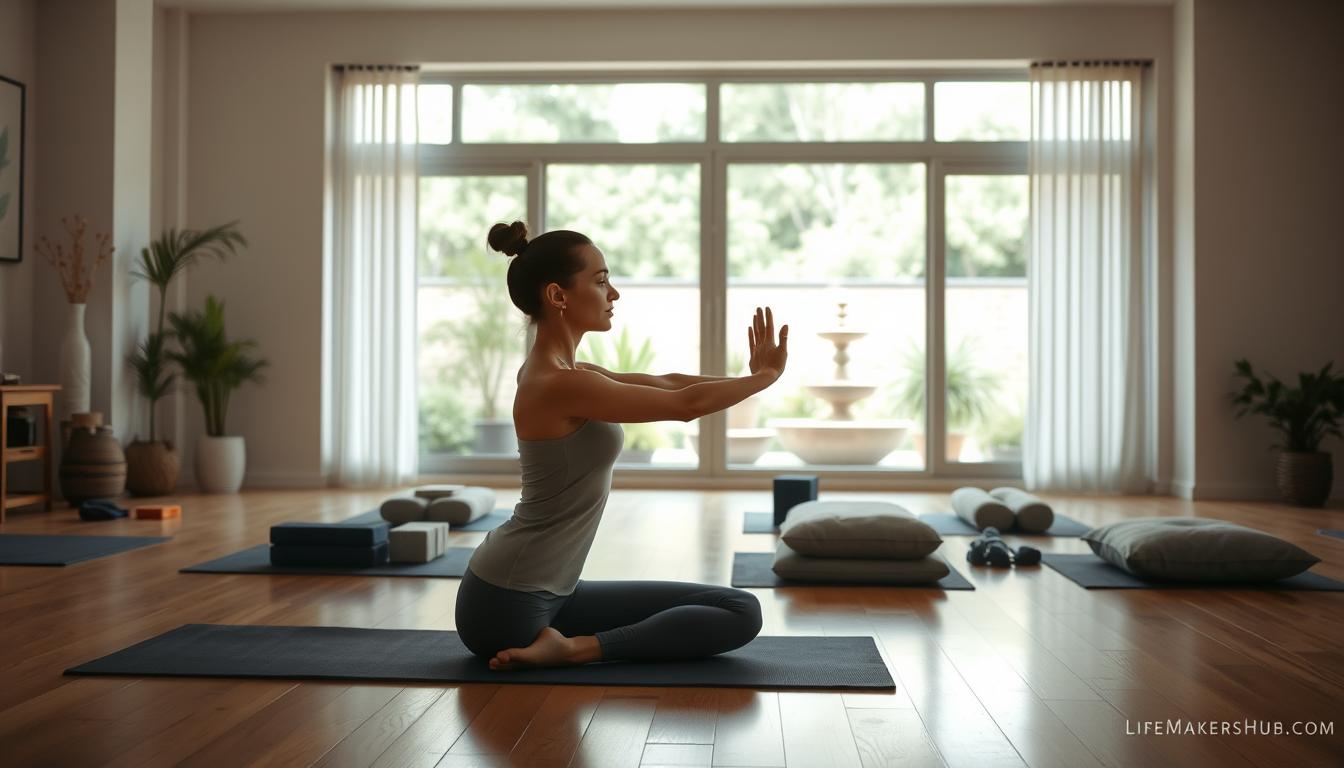2025 Yoga Poses to Reduce Stress
In today’s fast-paced world, finding effective ways to manage tension is essential. This article explores how specific movements can help you achieve a calmer state of mind. By combining ancient practices with modern techniques, we’ll guide you toward a more balanced lifestyle1.
Even a single movement can shift your body out of the fight-or-flight response, promoting relaxation. Experts like Shweta Jain and Anouska Shenn emphasize the transformative power of these practices2. Whether you’re new to this or a seasoned practitioner, there’s something here for everyone.
Discover how these techniques can enhance your well-being by fostering a stronger mind-body connection. From beginner-friendly options to advanced modifications, this guide covers it all. Let’s dive in and explore how you can start feeling more grounded today.
Key Takeaways
- Specific movements can help manage tension effectively.
- Ancient practices meet modern techniques for better results.
- Even a single movement can promote relaxation.
- Expert insights highlight the transformative potential.
- Options are available for all skill levels.
Introduction to Stress Relief Through Yoga
When life feels chaotic, turning to mindful movement can help restore balance. These practices integrate physical activity with focused breathing and meditation, creating a union of mind and body. This connection is key to reducing tension and promoting a sense of calm3.
Understanding the Mind-Body Connection
Your mind and body are deeply linked. When you move with intention, you activate this connection, which can help ease tension. For example, aligning your knee properly while on the floor can shift your focus away from stress and toward relaxation4.
Experts like Shweta Jain and Anouska Shenn emphasize the importance of this synergy. They note that combining movement with deep breath can counteract stress signals in the body3. This approach not only calms the nervous system but also enhances self-awareness.
What Makes Yoga an Effective Stress-Buster?
Mindful breathing and proper posture are essential. When you focus on your breath, you activate the parasympathetic nervous system, which promotes relaxation5. This simple act can make a big difference in how you feel.
Studies show that even a few minutes of practice can reduce cortisol levels, the hormone linked to stress3. Whether you’re on the floor or in a chair, these techniques can help you feel more grounded and at ease.
By integrating these practices into your routine, you can create a lasting sense of relief. It’s not about perfection—it’s about progress and finding what works for you.
Benefits of Yoga on Body and Mind
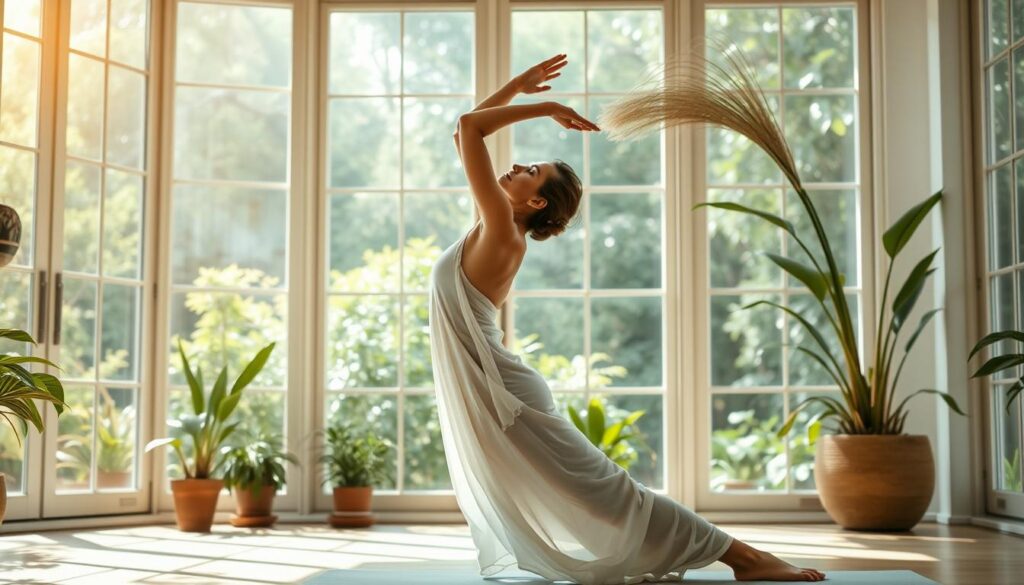
Finding balance in a hectic world starts with understanding how movement impacts both body and mind. These practices offer a holistic approach to wellness, addressing physical tension and emotional strain simultaneously. Let’s explore how these techniques can transform your daily life.
Physical Benefits: Posture, Flexibility, and Muscle Relief
Regular practice can significantly improve your posture and flexibility. By focusing on alignment, you can alleviate tension in your shoulder and leg muscles, promoting overall relaxation6. This not only reduces bodily strain but also enhances your range of motion.
Studies show that consistent movement helps release muscle tightness, especially in areas prone to stress7. Whether you’re sitting at a desk or standing for long periods, these techniques can provide much-needed relief.
Mental and Emotional Advantages
Beyond physical benefits, these practices are a powerful tool for mental clarity. Deep breathing techniques activate the parasympathetic nervous system, reducing symptoms of anxiety and promoting calm6.
Research highlights that mindful movement can lower cortisol levels, the hormone linked to stress7. This dual effect on body and mind makes it an effective way to enhance emotional balance and overall well-being.
By integrating these practices into your routine, you can create a lasting sense of calm and resilience. It’s not about perfection—it’s about progress and finding what works for you.
Yoga poses for stress relief 2025
Discover how simple movements can transform your daily routine into a calming experience. These techniques are designed to help you feel more grounded and relaxed, even in the busiest moments. Let’s explore some of the most effective practices for instant relaxation.
Overview of Top Poses for Instant Relaxation
Certain movements are particularly effective at easing tension. For example, the corpse pose can energize your body equivalent to eight hours of sleep8. Similarly, the child’s pose helps stretch the hip area, promoting circulation and calm9.
These practices are not just about physical stretch—they also activate the parasympathetic nervous system, reducing cortisol levels8. This dual effect makes them powerful tools for managing daily pressures.
How to Practice Safely and Mindfully
Proper alignment is key to maximizing the benefit of each movement. Start by placing your mat on a flat surface and ensure your hip alignment is correct to avoid strain9. Use props like pillows or blocks to adapt the poses to your needs.
Mindful practice involves focusing on your breath and listening to your body. Hold each position for 10 to 60 seconds, depending on your comfort level8. This approach not only enhances relaxation but also supports overall health.
Safety is paramount. Always warm up before starting and avoid pushing your body beyond its limits. By following these tips, you can enjoy the full benefit of these techniques without risk of injury.
Yoga Poses for Relaxation and Mindfulness
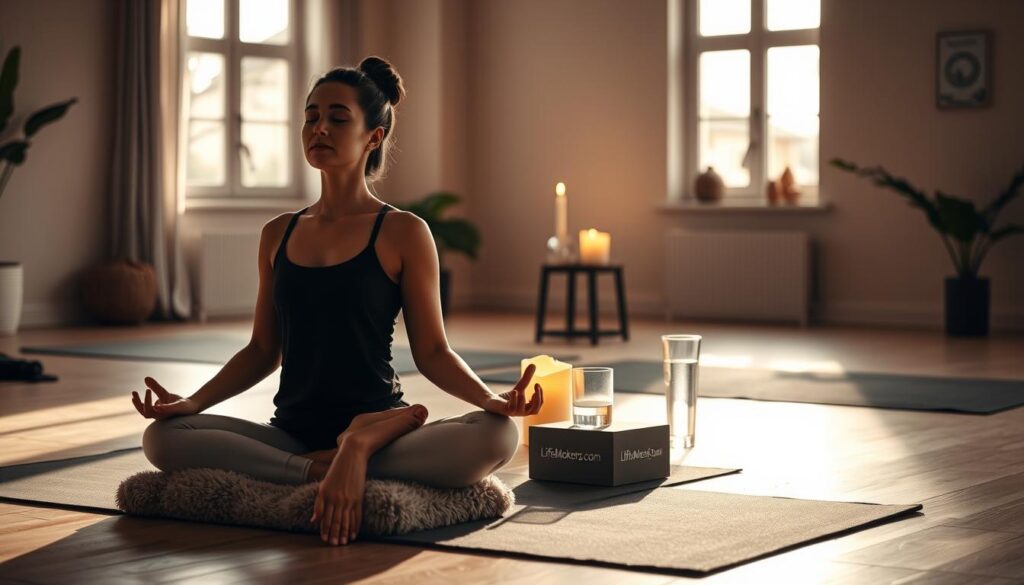
Creating a calm mindset begins with intentional breathing and mindful movement. These practices help release tension in the body, particularly in the spine and neck, while improving overall posture. By focusing on your breath, you can activate the parasympathetic nervous system, which promotes deep relaxation10.
Breathing Techniques and Pranayama
Controlled breathing, or pranayama, is a cornerstone of mindful practice. Techniques like inhaling for four counts and exhaling for six counts can shift your body’s response from stress to calm11. This simple method enhances oxygen flow and reduces tension in the neck and shoulders.
Research shows that even 10 minutes of focused breathing can lower cortisol levels and improve mental clarity10. Pairing these techniques with physical movement amplifies their benefits, creating a holistic approach to relaxation.
Meditative Practices to Calm the Mind
Meditation complements physical movement by fostering mental clarity and emotional balance. Practices like body scans or guided visualizations help release tension in the spine and promote better posture12.
Studies indicate that consistent meditation can reduce symptoms of anxiety and improve sleep quality11. By integrating these practices into your routine, you can achieve a deeper sense of calm and resilience.
| Technique | Benefits | Duration |
|---|---|---|
| Pranayama | Reduces tension, improves oxygen flow | 5-10 minutes |
| Body Scan Meditation | Releases spine tension, enhances posture | 10-15 minutes |
| Guided Visualization | Calms the mind, reduces anxiety | 10-20 minutes |
By combining breathing exercises with meditative practices, you can create a powerful routine that supports both physical and mental well-being. Start small, stay consistent, and watch how these techniques transform your daily life.
Expert-Recommended Techniques and Modifications
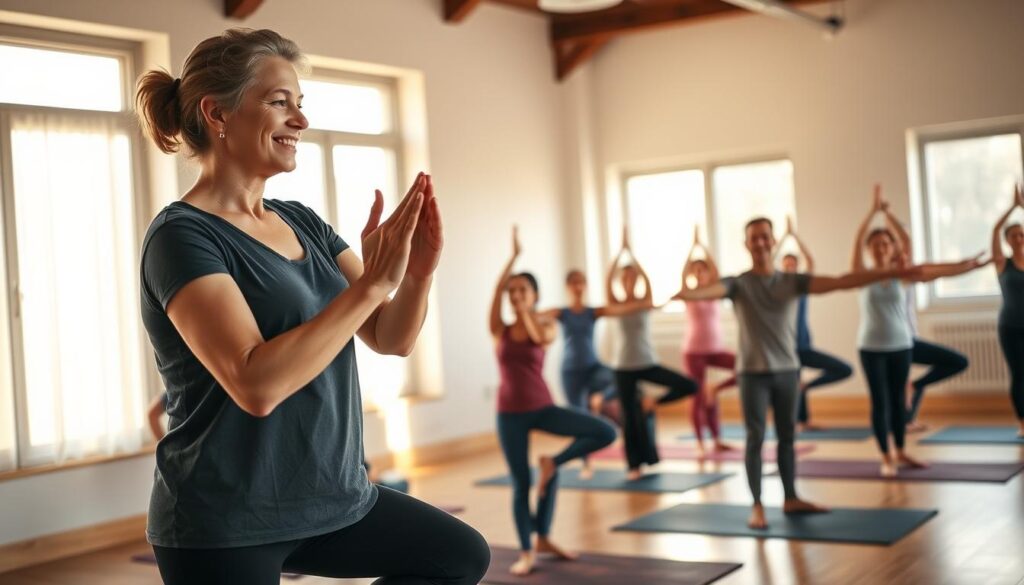
Adapting physical practices to fit your unique needs can make a world of difference in your daily life. Expert instructors like Shweta Jain emphasize the importance of tailoring movements to individual physical conditions. This ensures a safe and effective practice for everyone, regardless of their starting point13.
Adapting Poses for Different Physical Conditions
Modifying traditional positions can help you achieve better results without strain. For example, adjusting the position of your arm and hand can provide optimal side support, reducing the risk of injury14. Using props like blocks or straps can also make movements more accessible.
Setting a timer for a few minutes of practice can help you gradually build flexibility and relieve tension. This approach is especially helpful for beginners or those with limited mobility13. Listening to your body and making adjustments as needed ensures a comfortable and safe experience.
Common conditions like lower back pain or joint stiffness often require specific modifications. For instance, placing a cushion under your hips can ease discomfort during seated positions. Expert guidance can help you identify the best adjustments for your unique needs14.
| Condition | Modification | Benefit |
|---|---|---|
| Lower Back Pain | Use a cushion for seated poses | Reduces strain on the spine |
| Limited Mobility | Adjust arm and hand positions | Provides better side support |
| Joint Stiffness | Use props like blocks or straps | Increases accessibility and comfort |
By incorporating these expert-recommended techniques, you can create a personalized practice that supports your well-being. Remember, it’s not about perfection—it’s about progress and finding what works for your life.
Incorporating Mini Yoga Breaks into Your Daily Routine
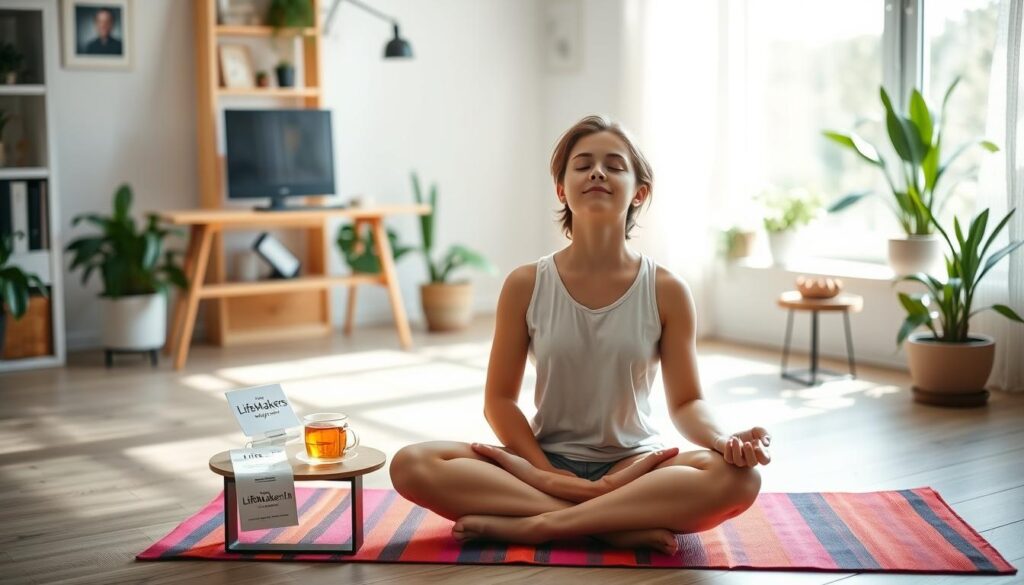
Even the busiest schedules can benefit from short, mindful breaks to reset and recharge. These pauses help rebalance your body’s system, reducing tension and improving focus. By dedicating just a few time slots to movement, you can create a calmer, more productive day15.
Quick Stress-Relief Poses for Busy Schedules
Short breaks don’t require much time but can make a big impact. For example, the cat pose is perfect for relieving tension in your arm side and spine. Simply get on all fours, arch your back, and hold for a few breaths. This movement helps reset your system and promotes relaxation16.
Another effective option is the seated twist. Sit upright, place one arm side on your knee, and twist gently. This pose stretches your back and shoulders, releasing built-up tension. Studies show that even 10 minutes of such movements can lower cortisol levels and improve mood15.
| Pose | Steps | Benefits |
|---|---|---|
| Cat Pose | Arch back, hold for 5 breaths | Relieves spine tension, calms the mind |
| Seated Twist | Twist gently, hold for 10 seconds | Stretches back, reduces shoulder strain |
| Forward Fold | Bend at hips, reach for toes | Releases hamstring tension, promotes calm |
Incorporating these mini breaks into your routine can help you manage yoga stress more effectively. Whether at your desk or at home, these movements are easy to fit into any schedule. Consistency is key—even a few time slots a day can lead to lasting benefits16.
Science and Study Insights on Yoga for Stress Management
Understanding the science behind mindful movement can transform how we approach daily challenges. Research shows that regular practice regulates the autonomic nervous system (ANS) and hypothalamic-pituitary axis (HPA), both critical for managing stress17. This effect helps reduce chronic tension and improve overall well-being.
Research Findings on Stress-Relieving Effects
Studies highlight that mindful movement increases activation of the prefrontal cortex (PFC), enhancing decision-making and goal-setting abilities17. It also positively impacts the amygdala, which processes emotions, and increases the volume of the hippocampus, linked to memory and learning17.
Physiological markers like cortisol levels and heart rate variability show significant improvements with consistent practice17. This way of managing stress not only calms the mind but also strengthens the body’s resilience.
Real-Life Case Studies and Expert Opinions
Real-life examples reinforce these findings. A 2024 study found that participants practicing Sudarshan Kriya Yoga (SKY) experienced a significant reduction in stress scores18. Another study showed that Isha yoga practitioners reported lower levels of mental distress and higher well-being compared to non-practitioners18.
Experts emphasize the role of meditation and controlled movement in reducing tension throughout the thigh and entire body. This holistic approach supports long-term stress management and improves quality of life19.
| Study | Findings | Impact |
|---|---|---|
| SKY Yoga (2024) | Reduced stress scores | Improved emotional well-being18 |
| Isha Yoga (2024) | Lower mental distress | Enhanced quality of life18 |
| Neuroimaging Study | Increased grey matter volume | Better memory and learning19 |
By integrating these practices into your routine, you can achieve a deeper sense of calm and resilience. The scientific evidence supports this way of life, offering a practical solution for managing stress effectively.
Conclusion
Taking small steps toward mindfulness can create a ripple effect of calm in your daily life. By incorporating simple practices, you can reduce tension in your chest and other areas, fostering a sense of balance. Studies show that even brief sessions can lower cortisol levels and improve mental clarity20.
Remember, it’s not about perfection—it’s about progress. Whether you’re dealing with depression or physical strain, gentle movements like the corpse pose can help. These techniques are backed by science and expert insights, making them reliable tools for managing daily pressures21.
Start small and stay consistent. Experiment with different practices to find what works best for you. Take a mindful step forward today and discover the transformative power of intentional movement.
FAQ
How does yoga help with stress?
What are the best poses for instant relaxation?
Can beginners practice yoga for stress relief?
How often should I practice yoga to manage stress?
Are there specific breathing techniques that help with anxiety?
Can yoga improve posture and reduce tension?
What if I have physical limitations? Can I still practice yoga?
How can I incorporate yoga into a busy schedule?
Is there scientific evidence supporting yoga’s stress-relieving effects?
Source Links
- 7 Calming Yoga Poses For Stress Relief
- 15 Relaxation Yoga Poses for Stress Relief in 2025 [Updated]
- The Benefits of Yoga for Stress and Flexibility
- High Point Pediatrics
- How Does Yoga Help with Stress? A Comprehensive Exploration
- How Yoga Can Improve the Stress in Your Life
- 12 Science-Based Benefits of Yoga
- 9 Yoga Poses That Can Help Relieve Stress
- The Best Yoga Poses for Stress
- 10 Best Yoga Poses for Stress Relief: Relax Your Body & Mind
- These 7 Yoga Poses Will Help You Relax (Even If You’re Really, Really Stressed)
- Top 9 Yoga Poses for Stress Relief [ Pose Guide] – moveOn 89 | Pilates | Fascia | Physio
- 12 tips to tame stress
- Yoga for Anxiety: 11 Poses to Try, Why It Works, and More
- Incorporating Stress-Relief Yoga into Your Daily Routine — Yoga Health Center
- How Yoga is a Stress Reliever: Embracing Wellness Through Mindfulness
- How Yoga Affects the Brain and Body to Reduce Stress | Stress Management
- New Research Shows Yoga Reduces Stress and Improves Well-Being
- The mind-altering power of yoga could improve your mental health
- Reducing Stress with Yoga: A Systematic Review Based on Multimodal Biosignals
- Frontiers | Reduce stress and the risk of burnout by using yoga techniques. Pilot study

